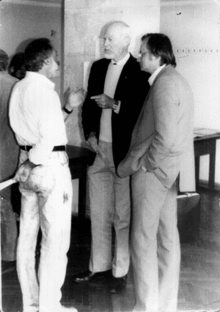Bryce DeWitt
Bryce Seligman DeWitt was born on January 8, 1923 (January 8, 1923 – September 23, 2004), he was an American theoretical physicist renowned for his work in gravitation and quantum field theory.
Bryce DeWitt | |
|---|---|
 Bryce (right) and Cécile (left) | |
| Born | Carl Bryce Seligman January 8, 1923 |
| Died | September 23, 2004 (aged 81) |
| Nationality | American |
| Alma mater | Harvard University |
| Known for | DeWitt notation Quantum Gravity Numerical Relativity |
| Spouse(s) | Cécile DeWitt-Morette |
| Awards | Dirac Prize (1987) Pomeranchuk Prize (2002) Einstein Prize (2005) |
| Scientific career | |
| Fields | Theoretical physicist |
| Institutions | Institute for Advanced Study University of North Carolina at Chapel Hill University of Texas at Austin |
| Doctoral advisor | Julian Schwinger |
| Doctoral students | Donald Marolf Steven M. Christensen Larry Smarr Ali Mustafazade |
_main_lecture_hall_1972.jpg.webp)

Life
He was born Carl Bryce Seligman, but he and his three brothers added "DeWitt" from their mother's side of the family, at the urging of their father, in 1950. In the early-1970s, this change of name so angered Felix Bloch that he blocked DeWitt's appointment to Stanford University and DeWitt and his wife Cecile DeWitt-Morette, a mathematical physicist, accepted faculty positions at the University of Texas at Austin. DeWitt served in World War II as a naval aviator. He died September 23, 2004 from pancreatic cancer at the age of 81. He is buried in France, and was survived by his wife and four daughters.
Work
He pioneered work in the quantization of general relativity and, in particular, developed canonical quantum gravity, manifestly covariant methods, and heat kernel algorithms. DeWitt formulated the Wheeler–DeWitt equation for the wave function of the universe with John Archibald Wheeler and advanced the formulation of Hugh Everett's many-worlds interpretation of quantum mechanics. With his student Larry Smarr, he originated the field of numerical relativity.
He received his bachelor's (summa cum laude), master's and doctoral degrees from Harvard University. His Ph.D. (1950) supervisor was Julian S. Schwinger. Afterwards, he held a postdoctoral position at the Institute for Advanced Study, in Princeton, NJ, worked at the Lawrence Livermore Lab, and then held faculty positions at the University of North Carolina at Chapel Hill and the University of Texas at Austin. He was awarded the Dirac Prize in 1987, the Pomeranchuk Prize in 2002, and the American Physical Society's Einstein Prize posthumously in 2005, and was a member of the National Academy of Sciences.
Books
- Bryce DeWitt, Dynamical theory of groups and fields, Gordon and Breach, New York, 1965
- Bryce DeWitt, R. Neill Graham, eds., The Many-Worlds Interpretation of Quantum Mechanics, Princeton Series in Physics, Princeton University Press (1973), ISBN 0-691-08131-X.
- S. M. Christensen, ed., Quantum theory of gravity. Essays in honor of the 60th birthday of Bryce S. DeWitt, Adam Hilger, Bristol, 1984.
- Bryce DeWitt, Supermanifolds, Cambridge University Press, Cambridge, 1985.
- Bryce DeWitt, The Global Approach to Quantum Field Theory, The International Series of Monographs on Physics, Oxford University Press, 2003, ISBN 978-0-19-851093-2.
- Bryce DeWitt, Sopra un raggio di luce, Di Renzo Editore, Roma, 2005.
- Bryce DeWitt, Bryce DeWitt's Lectures on Gravitation, Steven M. Christensen, ed., Springer, 2011.
Further reading
- David Deutsch, Christopher Isham, Gregory Vilkovisky (2005). "Bryce Seligman DeWitt". Physics Today. 58 (3): 84. Bibcode:2005PhT....58c..84D. doi:10.1063/1.1897570.CS1 maint: multiple names: authors list (link)
External links
- University of Texas obituary
- INSPIRE-HEP list of Dewitt's most famous papers
- Dirac Prize citation, International Centre for Theoretical Physics
- Einstein Prize citation, American Physical Society
- Oral History interview transcript with Bryce DeWitt February 28, 1995, American Institute of Physics, Niels Bohr Library and Archives
- Gaina Alex: The Quantum Gravity Simposim in Moscow, 1987 Gaina Alex: ГОСТИННАЯ:ФОРУМ: Александр Александров *Сборник рассказов*:РЕПРЕССИРОВАННАЯ НАУКА (PURGED SCIENCE)
- National Academy of Sciences Biographical Memoir
